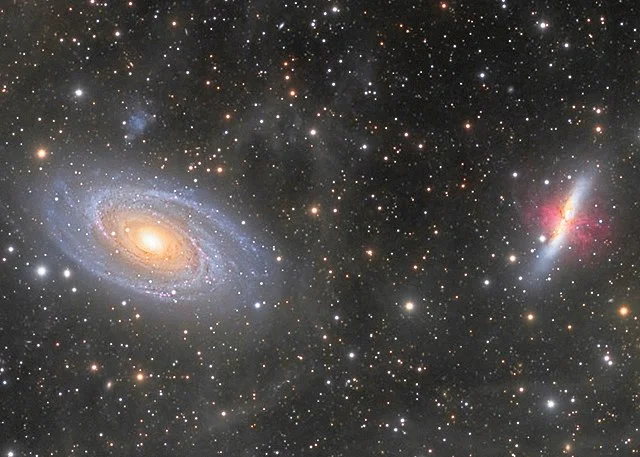Here are the highlights of the December sky:

Messier 81 and Messier 82, image: Leonardo Ciuffolotti, Andrea Pistocchini, Giuseppe Nicosia, Alessandro Falesiedi, Tim Stone, Giuseppe Donatiello (CC0 1.0)
- 11 pm, northeast sky – Ursa Major with the Big Dipper asterism, formed by the constellation’s seven brightest stars, and the galaxy pair Messier 81 (Bode’s Galaxy) and Messier 82 (the Cigar Galaxy), found along the imaginary line extended from Phecda through Dubhe
- 10 pm, northeast sky – Cassiopeia constellation, recognizable for its W asterism, with the binary star Eta Cassiopeiae (Achird), found between the brighter Gamma Cassiopeiae and Schedar (Alpha Cassiopeiae), and the open cluster Messier 103, located only a degree east of Ruchbah (Delta Cassiopeiae)
- 10 pm, northern sky – Cepheus constellation with the red supergiant Mu Cephei (Garnet Star), one of the largest known stars, and the magnitude 9.6 spiral galaxy NGC 6946, named the Fireworks Galaxy and notable for having hosted 10 supernovae in the past century
- 10 pm, northeast sky – Perseus constellation with the variable star Algol marking the head of the Gorgon Medusa and the open cluster Messier 34 located between Algol and Almach in the neighbouring Andromeda
- 10 pm, southwest sky – Orion constellation with the bright supergiants Rigel and Betelgeuse, the prominent Orion’s Belt asterism, and the bright Orion Nebula (Messier 42), the nearest star forming region to the Sun
- The Geminid meteor shower, active from December 4 to 17 and peaking on the night of December 13 to 14 around 2 am
- Jupiter and Saturn aligning to form a great conjunction in Capricornus on the winter solstice (December 21); it will be the closest conjunction of the two planets since 1623
Related articles: